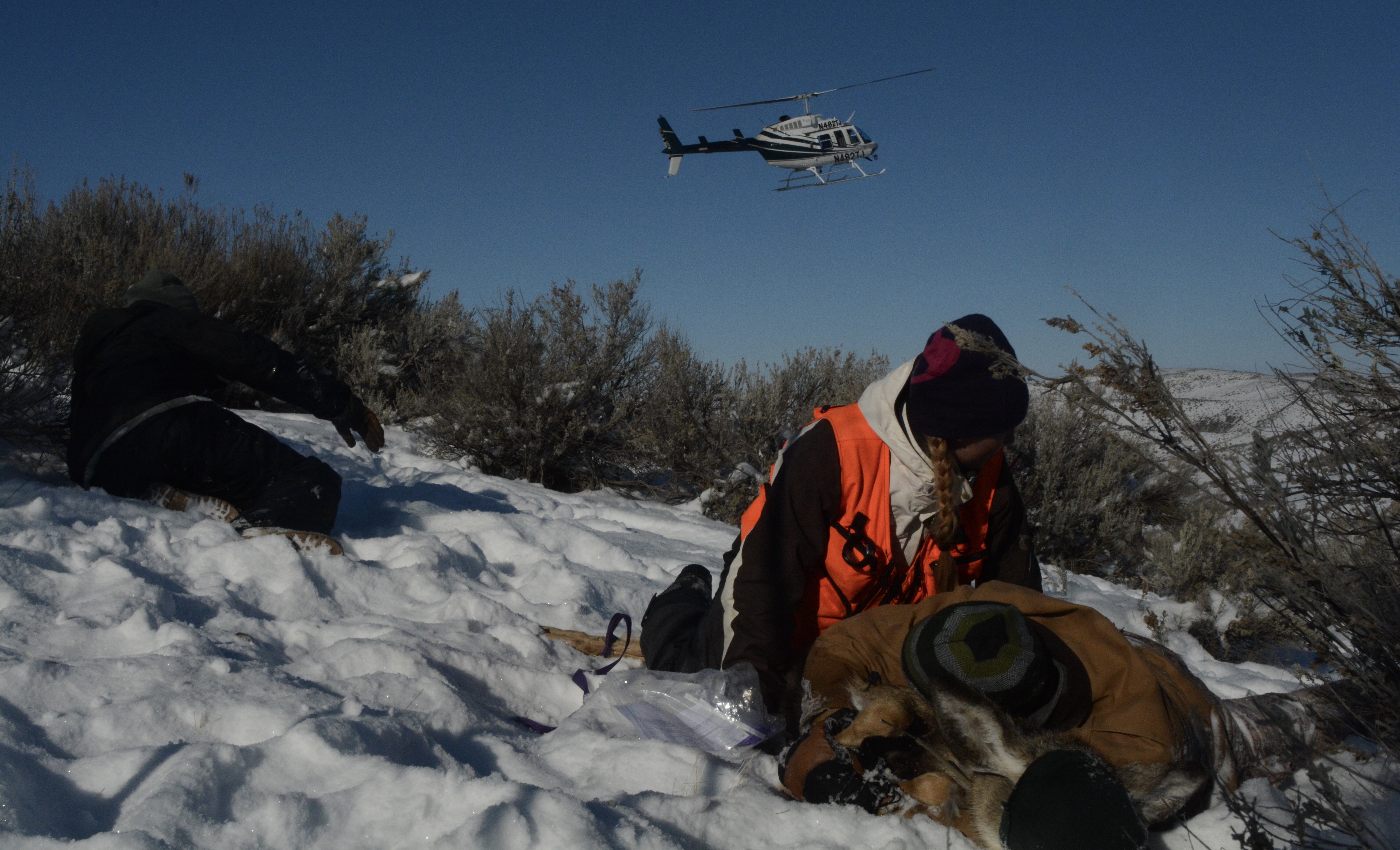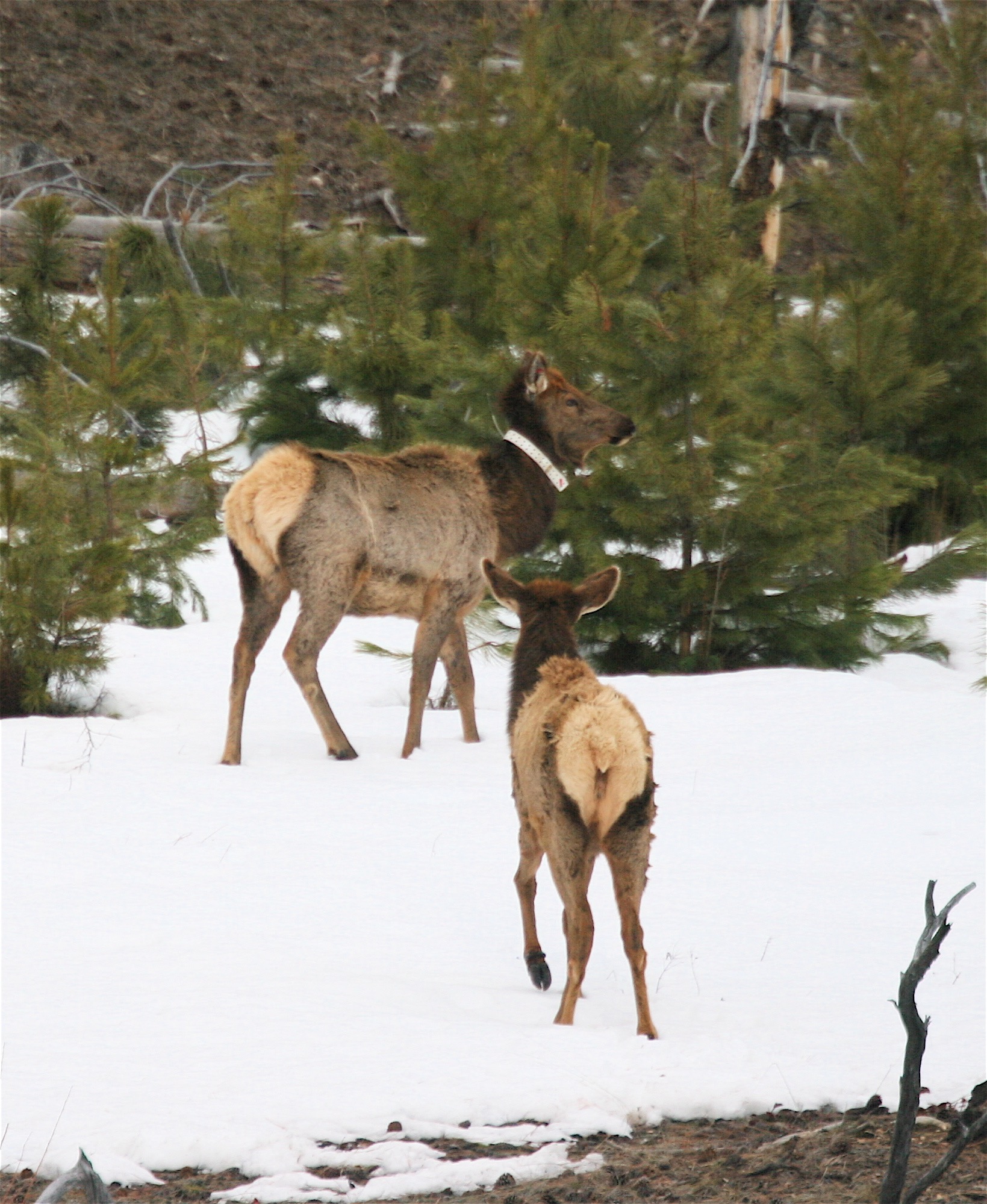
The whup, whup, whup of a helicopter grows louder as a herd of deer flees toward a trap. A small army of Fish and Game staff and volunteers hide as the animals run into a hidden net and become entangled.
People rush to the thrashing animals, and within seconds, untangle and calm them by placing a mask over their eyes and carefully pin their legs to their bodies. Then a quick, efficient routine begins as the animals are measured, weighed, health tested, and finally, fitted with a collar.
That scene is repeated dozens of times every winter for deer and elk, and it’s one of several ways Fish and Game captures big game animals and places collars on them to track their whereabouts and learn more about their seasonal movements and habits.
F&G does most of its capture-and-collar work during winter because animals tend to be congregated, easier to spot, and it’s typically gentler on the animals to capture them in cooler weather. It’s labor-intensive, and at times dangerous, but important work for managing big game herds.
Fish and Game crews will capture and collar about 400 deer and 400 elk this winter. Most collars go on fawns and calves to track their survival over winter, then those collars fall off after a few months as the animals grow.
F&G is adding more adults to the mix this year, which also provide valuable information, including migration routes, location of fawning and calving areas, important winter and summer range, and whether animals are loyal to certain areas during winter or summer, or if they wander.
The data also plugs into Fish and Game’s “integrated population model,” which is a method of analyzing data from collars, harvest statistics and aerial surveys to determine overall game populations and whether they're increasing or decreasing.

Radio collars have been used for decades to track animals, but advancements in GPS collars that link with satellites give Fish and Game biologists a better opportunity to learn about animals without having to track them in the field, which they have to do with VHF radio collars. A biologist can track an animal with a GPS collar in real time from any computer and know exactly where they are, where they’ve been, and night or day in any weather for up to four years.
When an animal dies, the collar also emits a mortality signal when it remains stationary for a prolonged period. That triggers biologists to go into the field, find the carcass and determine the cause of death by performing a “necropsy,” which is an animal version of an autopsy. If it was killed by a predator, they can usually determine whether it was a bear, mountain lion or wolf based on how it was killed and how the animal, or animals, fed on it.
“We have a better handle on what’s causing mortality, and that’s a big benefit of GPS collars over radio collars,” said Mike Elmer, F&G’s data coordinator.
Aside from providing lots of important data, GPS collars also provide some interesting (and entertaining) insights and head-scratching moments when animals do the unexpected, and here are some examples.
Whitetail maternity migration?
White-tailed deer are known for being home bodies, and unlike their mule deer cousins, they don’t typically make seasonal migrations. But one did, and University of Idaho graduate student Kayte Groth explains the unexpected travels of a whitetail doe:
In spring of 2017, we captured 40 white-tailed does by helicopter and placed GPS collars on them, which allows me to track locations every 15 minutes. I noticed a particular doe was captured in April in Middle Potlatch Creek canyon just southeast of Moscow.
The doe remained there for about two months until about 4 a.m. on June 12, when she left the canyon. Two days and 20 miles later, she arrived at a new destination and settled on a canyon rim overlooking the Snake River.
She remained there until July 25, then traveled 20 miles back to her original capture location in Middle Potlatch Creek.
“Although we aren’t certain why this particular doe embarked on such a journey, we speculate it was due to fawning,” Groth said.
She may have felt safer on the canyon rim, and once she felt that her fawn was big enough to avoid predators, she returned. Traveling back with a newborn fawn likely slowed her travels and might explain why it only took her two days to reach the fawning area, but six days to return home to Middle Potlatch Creek.
Vagabond cow elk
We often think we know how and why big game animals migrate. They typically follow the family or herd as it travels from winter range to summer range and back again. It’s a fairly predictable migration as animals often use the same, or similar, winter and summer ranges throughout their lives.
Or do they?
Senior Wildlife Technician Clint Rasmussen tracked two cow elk that seemed to have first-class cases of wanderlust.
One was captured and collared in 2015 about 6 miles east of Fairfield in January 2015 while on winter range. She then migrated about 40 miles almost due north and summered near Alturas Lake.
Nothing out of the ordinary there, but in the 2016 winter, she overshot Fairfield and proceeded nearly 75 miles south from Alturas Lake and wintered in the Hammett area near the Snake River. Maybe winter conditions forced her farther south that year, or something else, it’s difficult to know. But she returned to Alturas Lake again for the summer of 2016.
Clearly she enjoys summers at Alturas Lake, and if you’ve ever seen this sparkling mountain lake in the Sawtooths, it’s easy to see why. But apparently, she isn’t as faithful to her winter range because, in 2017, instead of following the geese south, she headed northeast about 45 miles to Antelope Flat near Clayton.
Where did she go for summer, 2017? You guessed it. Alturas Lake.
Another cow elk was captured in January 2015 on the east side of Magic Reservoir about 25 miles north of Shoshone. Then it migrated about 80 miles west during the following spring and summered south of Arrowrock Reservoir, which is east of Boise. In winter of 2016, it took a relatively short hop southwest about 25 miles and wintered near Mountain Home.
Her wanderlust kicked in again the following winter, and she traveled northwest about 65 miles and summered north of Banks above the North Fork of the Payette River, then wintered about 30 miles south in the Boise Foothills.
Her travels ended on May 13, 2017 just south of Arrowrock Reservoir when her collar registered a mortality signal. Biologists found the dead elk and determined she was killed by a mountain lion.
Collar malfunction, or visiting Uncle Ted?
Biologist Josh Rydalch shares a story about a wandering mule deer, and how GPS collars have changed what he jokingly refers to as “collar and foller” biology.
Rydalch had a mule deer fawn GPS collared in in the Birch Creek area west of Dubois in hunting Unit 59A in December 2015.
In April 2016, it started traveling north as green up occurred, which is like “surfing the green wave to summer range,” Rydalch said.
The deer took a long jaunt north near Bozeman, Montana, and by late July/early August, it reached the Belgrade area. It lived on media-mogul Ted Turner’s ranch that summer, a distance of about 120 miles from where it was collared. But the unusual thing about this deer is it didn’t return in the fall like most mule deer.
If the deer had a traditional VHF radio collar, biologists would have to physically travel to the general proximity of the animal to determine its exact location, and it's highly unlikely they would have traveled to Belgrade, Montana to look for it.
“This is an example of what these GPS collars are showing us,” Rydalch said. “In the past, we likely would have lost track of this deer and probably dismissed it as having a malfunctioning VHF collar and wrote it off.”
The doe died about a year after it was collared, and with permission from the Turners, biologists ventured onto the ranch, found the doe and determined a mountain lion killed it.
“I am grateful they let us on to investigate the scene and recover the GPS collar,” Rydalch said. “We wouldn’t have known the animal’s location or cause of death without it.”
Wandering, lovestruck rams
GPS collars provide an interesting glimpse into the lives of bighorn sheep. Biologist Rachel Curtis has been part of team of biologists tracking animals in the Owyhee Desert, where they captured and collared rams and ewes in 2016 and 2017.
It’s an important time for bighorns because prior to collaring the animals, there was a deadly pneumonia outbreak in Oregon’s adjacent bighorn herds, and biologists needed to know if it affected Idaho’s sheep.
But the collars showed Curtis much more than whether an animal was alive or dead. It showed seasonal movements, or lack thereof, and how rams behavior differs from ewes.
“It's been interesting to watch their movements for the last two years because the ewes have been very loyal to their home range and stay close to the canyon, particularly when their lambs are young,” she said.
Rams, on the other hand, are prone to wandering.
“Sometimes we can tell what's motivating them to move, and other times, we can only guess,” Curtis said.
As soon as hunting season starts, rams move if they are spooked. They’re often bumped out of their typical home range and travel miles away and on the opposite side of a ridge. One traveled about six miles after being disturbed.
While six miles might be an afternoon jaunt for deer or elk in sagebrush country, in the Owyhee Canyonlands, it means navigating steep canyons, crossing rivers and finding a notch through vertical bluffs on the other side, and often repeating that sequence several times.
But that’s their home turf, and as Curtis observed, rams aren’t shy about roaming, especially when the rut starts.
One went on a walkabout looking for ewes that took him five miles to the rim of a plateau overlooking Duck Valley. Not finding any ewes there, he stayed one night and returned home the next day.
And sometimes rams roam for unknown reasons. One ram was very faithful to his home range in a particular stretch of the Owyhee River, or up one small side canyon. But in April 2017, he spent a week walking 15 miles upriver, then turned around and went back.
One of the key facets of bighorn management is disease control, so it’s important that biologists know if bighorns leave one herd and intermingle with others, and information provided by GPS collars assist biologists in knowing if that occurs.
Calendar migrations
It’s not always individual animals that surprise biologists. F&G’s Elmer sees certain deer herds that migrate seasonally, regardless of the weather. Unit 39’s mule deer in the Boise River drainage are a prime example. Rain, shine or snow, they start migrating downhill during the third week of October.
“It’s like clockwork,” Elmer said. “For this particular group of animals, it seems to be a time-frame thing more than weather.”
He said they’ve learned other herds in south/central Idaho have similar time-based migrations regardless of the weather.
GPS collars have changed the game for biologists and technicians by providing and cataloging an animal's location, rather than F&G staff driving several times a month to track animals via radio signals, or flying in aircraft to locate them.
When an animal with a radio collar died, unless the timing was perfect, it might take days or weeks to discover it died and find the carcass. By then, a necropsy was difficult, not to mention smelly, and getting good information on what killed the animal was often a challenge.
Here's about collaring big game:

